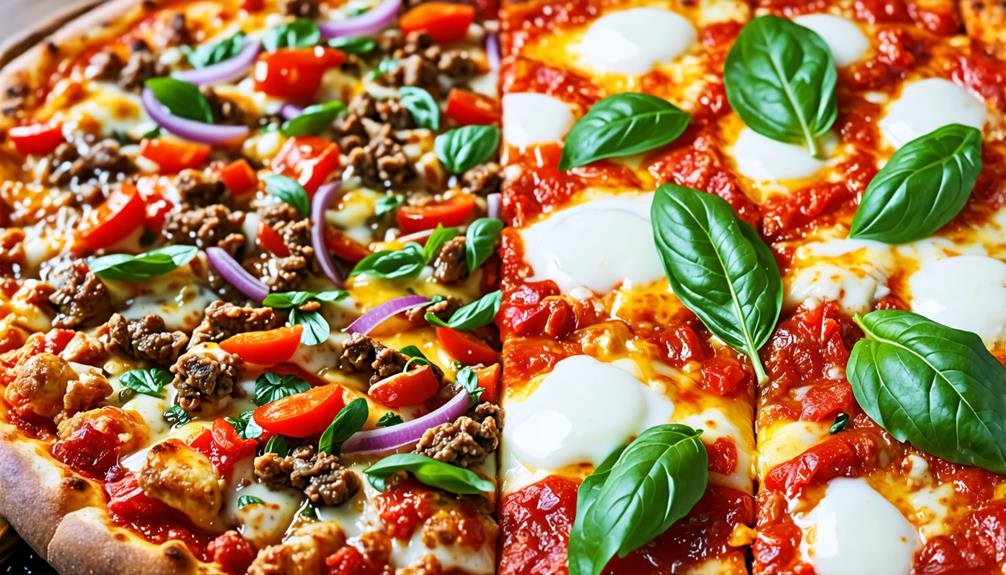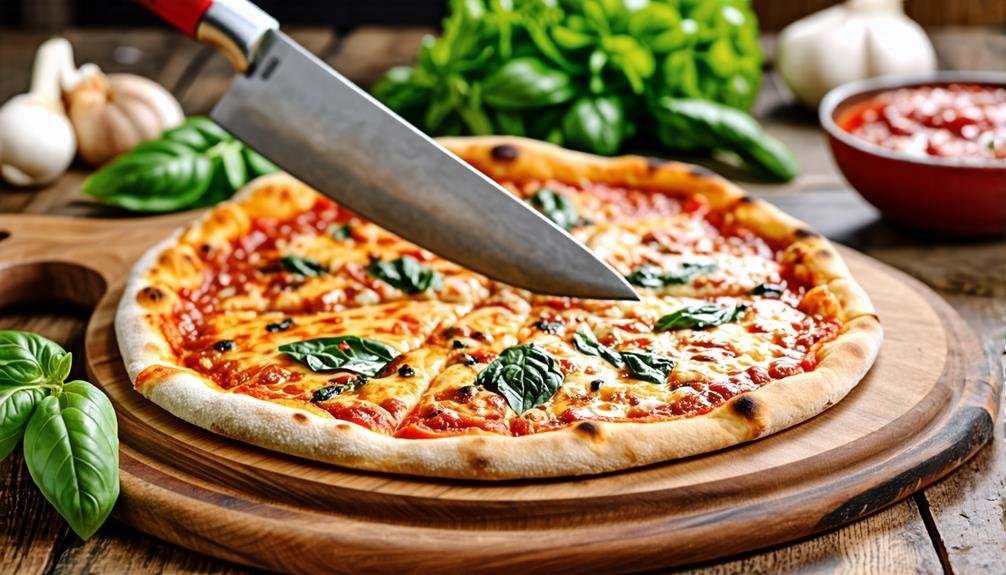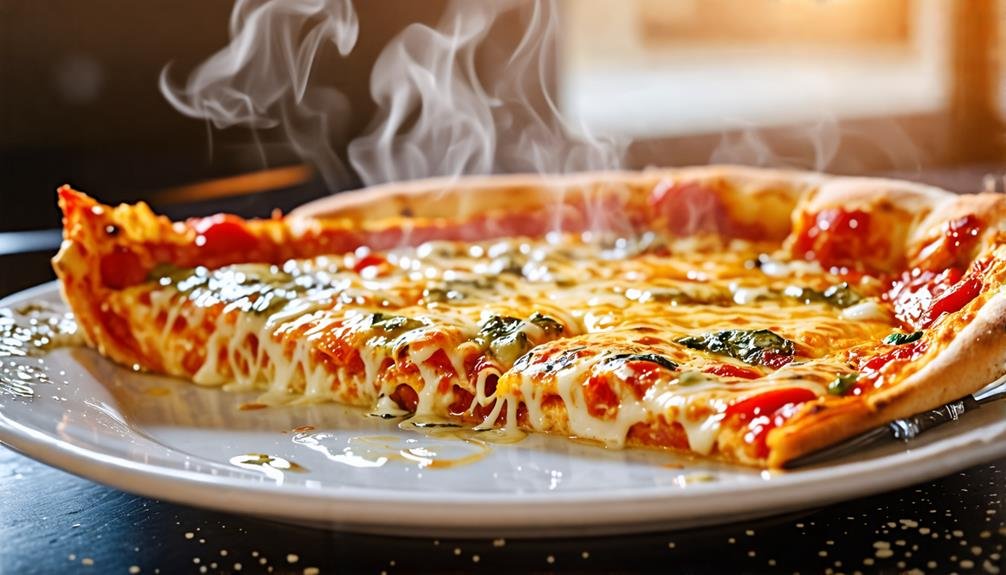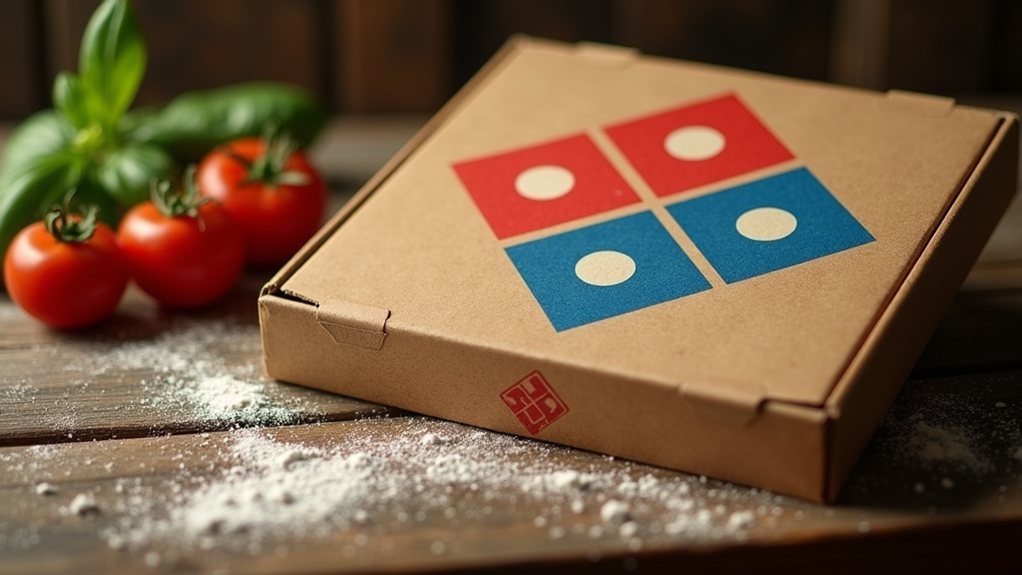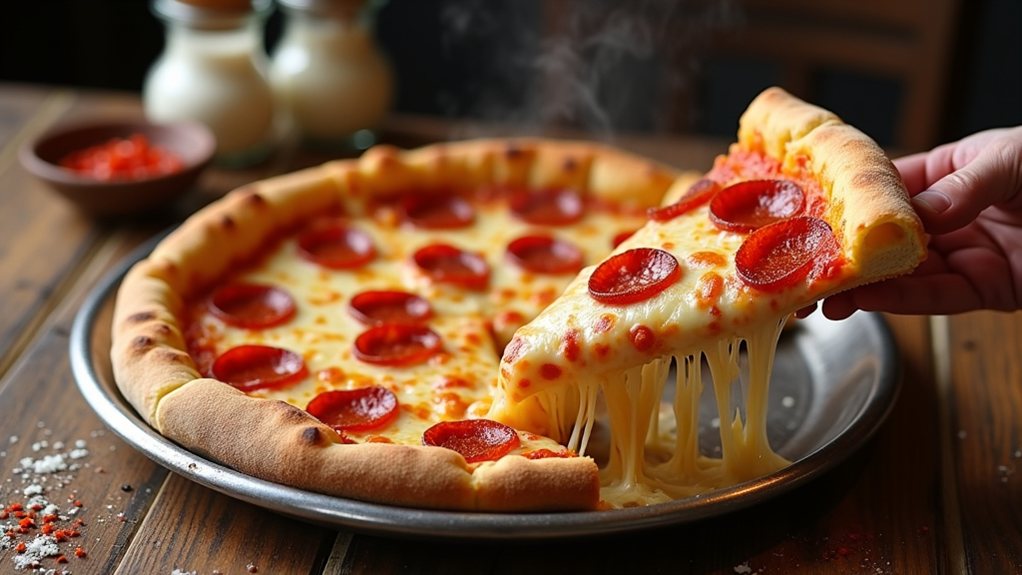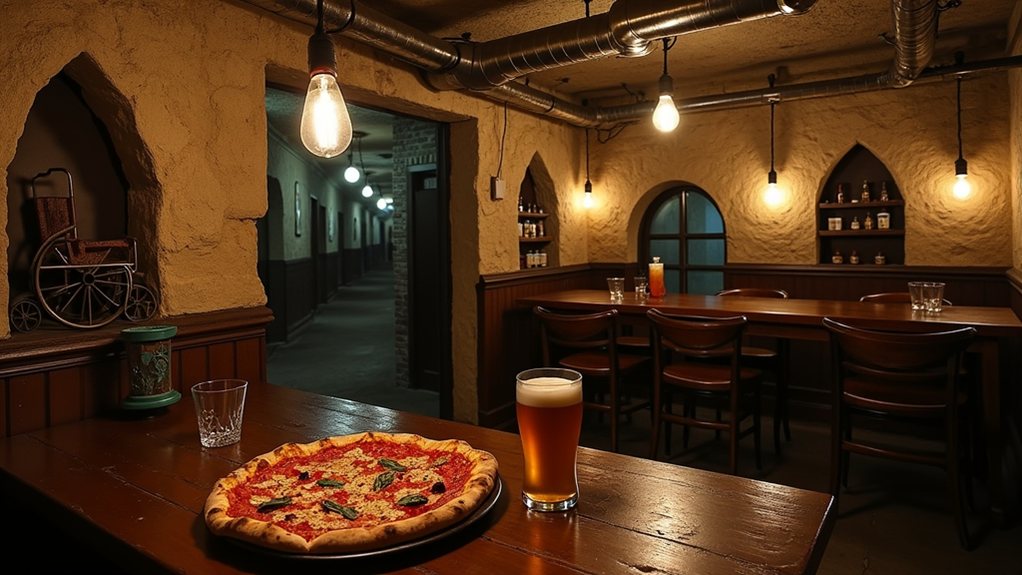Avoiding excessive pizza toppings is crucial for maintaining both texture and flavor. Too many toppings can lead to a soggy crust, as high-moisture ingredients prevent the dough from cooking evenly and releasing moisture effectively. This imbalance not only affects the crust but also disrupts the baking process, resulting in an unappetizing experience. Limiting toppings to four or five allows for better heat circulation and guarantees a well-cooked base. Additionally, pre-cooking moisture-rich ingredients can further improve the pizza's integrity. By practicing moderation and carefully selecting toppings, you achieve a balanced and enjoyable culinary experience that brings out the best flavors. More insights await.
Issues With Excessive Toppings
Excessive toppings on pizza can spoil the quality of the crust, resulting in a soggy and unappetizing base. While the idea of a fully loaded slice from brands like Domino's or Papa John's might be appealing, too many ingredients can interfere with the baking process, diminishing the overall enjoyment. When overloaded with items such as mozzarella, pepperoni, and green olives, the dough has difficulty releasing moisture during baking, leading to a damp and floppy crust.
Moist ingredients, especially those with high water content like olives and jalapeños, worsen the situation by trapping water between the layers. This moisture retention not only adds to the sogginess but also disrupts even cooking, causing the top to burn while the base remains undercooked.
To ensure a pleasurable pizza experience, it's important to follow guidelines that promote moderation. Limiting the toppings to four or five choices allows the dough to breathe and achieve a well-balanced texture. By recognizing the effects of excessive ingredients, pizza lovers can create a dish that respects the dough's quality and provides a delightful culinary experience. Strive for a harmonious selection of toppings to elevate your pizza experience.
Impact on Crust Quality
The quality of a pizza crust is significantly influenced by the selection and quantity of toppings. Excessive ingredients can hinder the dough's ability to release moisture during the baking process. A balanced pizza, such as those crafted by Domino's or Papa John's, allows the crust to breathe, achieving a desirable texture—crispy on the outside and tender on the inside. When toppings are overindulged, moisture retention becomes a major concern, resulting in a soggy crust that diminishes the overall dining experience.
Ingredients with high moisture content, like bell peppers or fresh mushrooms, can worsen this issue, further compromising the crust's structure. An overloaded pizza may also lead to uneven baking; while the toppings could char, the underlying dough might remain undercooked. This imbalance not only impacts the flavor but also detracts from the enjoyment of the meal.
To fully appreciate your pizza, consider how the toppings interact with the crust. The skill in pizza making lies in achieving a harmonious balance between ingredients and dough, allowing each component to shine while preserving the essential quality of the crust. A careful approach to selecting toppings is crucial for an enjoyable culinary experience.
Guidelines for Topping Quantity
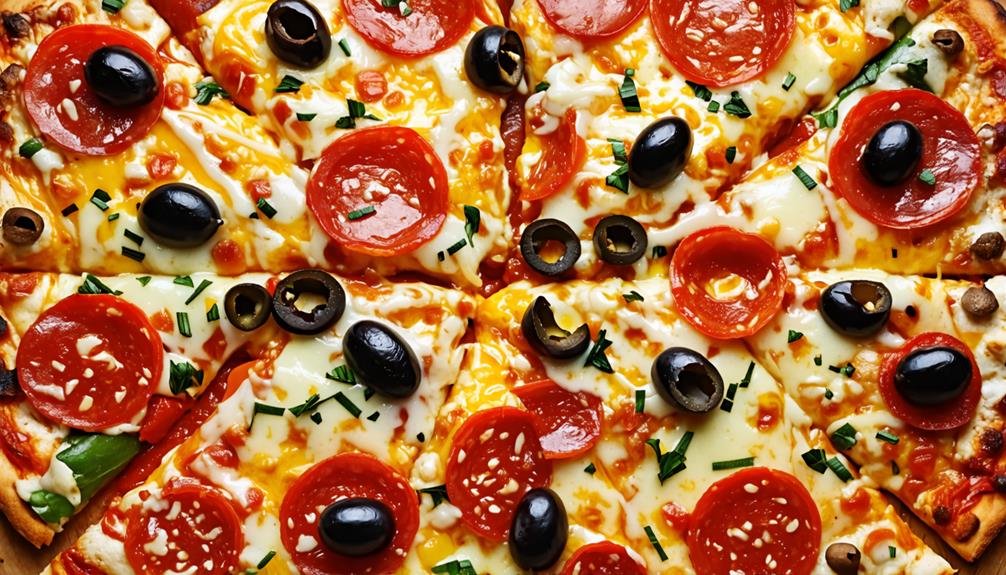
In terms of topping quantity, moderation is crucial for achieving the perfect pizza. Ideally, limit your toppings to four or five to guarantee even baking and a well-cooked crust. Moreover, consider sprinkling toppings rather than heaping them on, and pre-cook wet ingredients to minimize moisture retention and improve texture.
Limit to Four Toppings
Limiting pizza toppings to four enhances the baking process, ensuring a well-cooked crust and balanced flavors. When you restrict toppings, you allow the dough to perform optimally, releasing moisture as it bakes. This moisture release is crucial; excessive toppings can lead to a soggy crust that is unappealing and hard to enjoy.
By selecting a maximum of four toppings, you enrich the overall flavor profile of your pizza. Each ingredient can shine, creating a harmonious blend rather than a muddled mix. This simplicity encourages the use of high-quality ingredients, elevating the entire experience.
Moreover, moderation in toppings helps prevent uneven baking. When too many ingredients are piled on, the top can burn while the crust remains undercooked, resulting in a frustrating outcome. Remember, pizza is an art, and like any artist, you should choose your ingredients carefully. Embrace the freedom to experiment, but remember that less is often more in toppings. The pursuit of pizza perfection lies in balanced choices that respect the integrity of the dough.
Sprinkle, Don't Heap
Creating the ideal pizza involves a careful strategy for topping distribution, focusing on a gentle scattering rather than a dense layering of ingredients. This approach helps preserve a crispy crust while allowing the distinct flavors of each topping to shine. Striking the right balance is crucial for effective baking, as an overabundance of toppings can lead to a soggy base and uneven cooking.
Consider these four tips when adding toppings to your pizza:
- Cap at Four or Five Toppings: Too many ingredients can overwhelm the pizza and compromise the crust's texture.
- Disperse Evenly: Rather than heaping, evenly spread toppings across the dough to promote uniform heat distribution during baking.
- Emphasize Moderation: Use a controlled amount of each topping to avoid excess moisture that can result in a damp crust.
- Harmonize Flavors: Choose toppings that enhance each other while providing a variety of textures and tastes.
Pre-Cook Wet Ingredients
To achieve the best crust quality, it's recommended to pre-cook moist toppings like bell peppers and mushrooms. This process significantly lowers their water content, preventing the crust from becoming soggy during baking. Sautéing or roasting these vegetables enhances their flavors, leading to a more balanced pizza.
By pre-cooking your toppings, you allow the crust to cook evenly, avoiding that undesirable floppy texture. It's also important to be mindful of the quantity of toppings; using four or five allows the crust to crisp up properly without being overloaded.
Sprinkling toppings, rather than heaping them on, ensures even distribution, which enhances the overall flavor while maintaining the integrity of the dough. A mix of dry and pre-cooked moist ingredients, such as pepperoni and sautéed spinach, creates a delightful culinary balance.
Ultimately, investing time in preparing moist toppings ahead of time enriches your pizza-making experience, resulting in a well-cooked crust that can support your favorite toppings. Follow these tips for an enjoyable pizza creation journey.
Strategies to Avoid Soggy Crust
Creating a delicious pizza requires careful selection of toppings and managing moisture to avoid a soggy crust. Here are four essential strategies to enhance your pizza-making process while ensuring a crisp base:
- Pre-cook Moisture-Rich Vegetables: Ingredients such as Portobello mushrooms, sweet bell peppers, and fresh spinach hold a lot of water. By sautéing these vegetables before adding them to your pizza, you can significantly decrease their moisture content, preventing sogginess in the crust.
- Limit Topping Variety: Stick to four or five toppings at most. This helps the pizza dough cook thoroughly, allowing it to release moisture effectively during the baking process.
- Distribute Toppings Evenly: Spread your ingredients uniformly across the pizza. This technique avoids heavy spots that can lead to uneven baking and helps achieve a better texture overall.
- Avoid Excessive Topping Volume: It can be tempting to load your pizza with numerous ingredients. However, overloading can cause uneven cooking, leaving the crust undercooked while the toppings risk burning.
Achieving the Perfect Pizza
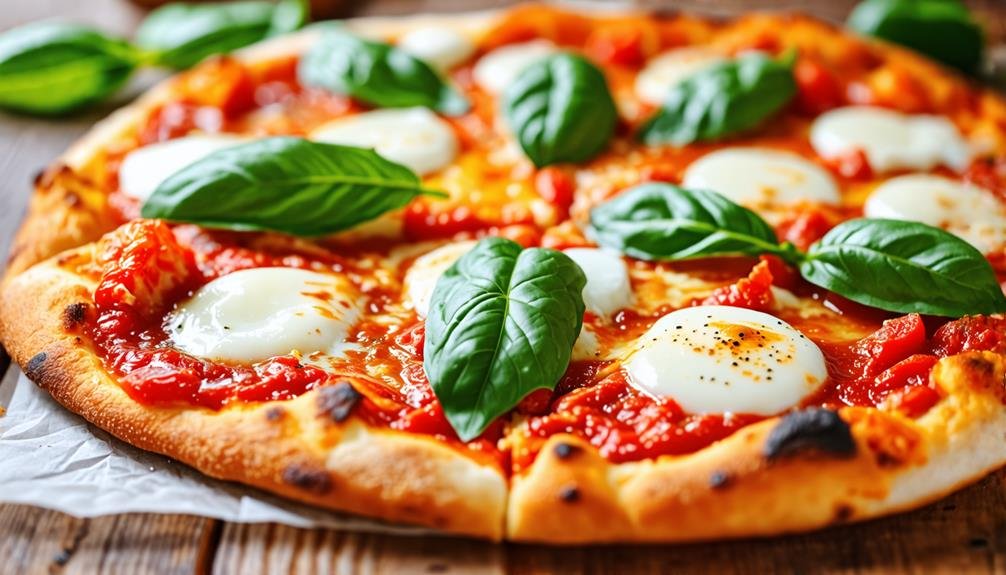
Achieving the perfect pizza requires a careful balance of flavor and texture, emphasizing the importance of moderation in topping selection. By experimenting with different combinations while restricting the quantity of toppings, one can improve the overall quality of the crust and prevent sogginess. Moreover, preparing ingredients in advance guarantees that each component adds positively to the final product, leading to a tasty and well-structured pizza.
Flavor and Texture Balance
Balancing flavors and textures is crucial for creating a delightful pizza that satisfies the taste buds while preserving the crust's structure. To achieve this balance, consider how each ingredient interacts and the overall composition of the pie. Overloading with toppings can result in a muddled flavor profile, making it difficult to enjoy each component.
To help you find the perfect equilibrium, implement these four approaches:
- Choose Complementary Ingredients: Pick toppings that enhance one another, like sweet bell peppers paired with savory Italian sausage or zesty Kalamata olives alongside creamy mozzarella.
- Mix Textures: Combine crunchy toppings, such as crispy bacon, with softer elements like sautéed portobello mushrooms for an intriguing mouthfeel.
- Focus on Quality: Select fresh, premium ingredients, like organic tomatoes and artisanal cheese, to ensure every bite bursts with flavor, enhancing the overall enjoyment.
- Ensure Even Distribution: Spread your toppings uniformly to avoid any section becoming excessively soggy, maintaining a consistent texture across the entire pizza.
Moderation in Topping Selection
Selecting pizza toppings thoughtfully is essential for preserving the quality of the crust while enhancing overall flavor. It's best to limit your choices to four or five toppings, as too many can spoil the experience. Overloading a pizza can lead to moisture issues, making the crust soggy. To achieve the right balance, add toppings sparingly and with intention.
For instance, pre-cooking wet ingredients like mushrooms or bell peppers can help reduce their moisture before adding them to your pizza. This small preparation step contributes to a crispier crust. Moreover, evenly spreading toppings across the pizza surface ensures proper cooking. A well-considered mix of flavors and textures not only elevates the taste but also promotes a well-baked crust.
Trying out various topping combinations can be a fun culinary journey, yet it's crucial to keep moderation in mind. By practicing restraint and making careful topping selections, you can craft a pizza that satisfies the palate while maintaining a delicious, perfectly cooked crust.
The Role of Moisture in Baking
Moisture significantly influences the baking process, impacting both the texture and strength of the pizza crust. When a pizza is overloaded with toppings, the delicate balance of moisture can be disrupted, resulting in a soggy crust. Recognizing the importance of moisture is crucial for crafting the ideal pizza.
- Moisture Release: For the crust to achieve a satisfying crunch, it must release moisture during baking. Excessive toppings hinder this release, leading to a wet base.
- Ingredient Selection: High-moisture ingredients, such as fresh bell peppers or mozzarella cheese, complicate the baking process if not managed correctly.
- Baking Temperature: A high oven temperature is essential for a crispy crust, but an abundance of toppings can obstruct heat circulation, causing uneven baking.
- Dough Breathing: The dough requires space to expand; if overwhelmed by too many toppings, the outcome can be a dense and unappealing texture.
Balancing Flavor and Texture
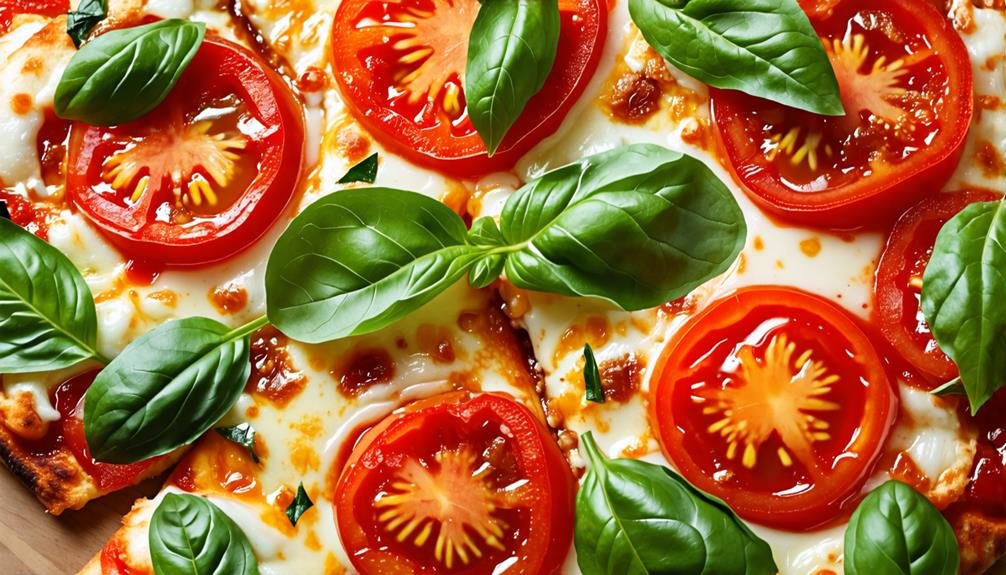
Balancing flavor and texture is vital for creating a fulfilling pizza experience. While diverse toppings can improve taste, an overload can compromise the integrity of the crust, leading to sogginess and uneven cooking. To achieve the ideal combination, it is important to select a harmonious variety of toppings while maintaining moderation to guarantee both flavor and texture are optimized.
Flavor Harmony Matters
Creating a harmonious pizza flavor experience involves carefully selecting toppings that work together to enhance the overall taste while ensuring varied textures. A pizza that achieves this balance not only satisfies the taste buds but also heightens the enjoyment of each bite. Here are some essential tips:
- Choose Flavor Companions: Opt for toppings that complement one another, like the sweet notes of caramelized onions paired with the savory tang of feta cheese.
- Balance the Components: Maintain an even ratio of sauce, cheese, and toppings. Overloading on cheese or sauce can mask subtle flavors.
- Variety in Texture: Include an assortment of textures, such as crunchy bell peppers alongside creamy mozzarella, to provide a delightful mouthfeel.
- Fresh Seasonal Produce: Incorporate locally sourced, in-season vegetables for enhanced flavor and freshness, making your pizza not only taste better but also more enjoyable overall.
Texture Impact Considerations
The relationship between texture and flavor is essential in making a pizza that excites the taste buds, as each topping plays a role in the overall sensory experience. Achieving the right balance between these components is crucial; an excess of toppings can disrupt this balance. A well-cooked crust, like that of a Domino's pizza, is critical to quality, requiring the dough to release moisture effectively while baking. When overloaded with toppings, particularly moist ingredients such as black olives and bell peppers, the crust struggles to cook evenly, resulting in a soggy, unappealing base.
Keeping toppings to a moderate number, around four or five, ensures a more unified textural experience, allowing each ingredient to shine without overwhelming the others. The arrangement of toppings is also important; a light sprinkle instead of a heavy pile helps maintain the crust's structure. Pre-cooking wet ingredients can help reduce moisture retention, ensuring the final product is crispy and flavorful.
In the end, harmonizing flavor and texture enhances not just the pizza but the entire dining experience. By honoring the relationship between these aspects, pizza lovers can create culinary masterpieces that celebrate both taste and texture.
Pre-Cooking Ingredients
Pre-cooking toppings, particularly those with high water content, is essential for achieving a crisp and flavorful pizza crust. When ingredients like vegetables and meats are placed directly onto the dough, they can release excess moisture during baking, leading to a soggy crust. To avoid this, pre-cooking is a smart technique that enhances both taste and texture.
Here are four toppings that greatly benefit from pre-cooking:
- Cremini Mushrooms: Sautéing cremini mushrooms reduces their moisture content, helping to keep the crust crispy.
- Sweet Bell Peppers: These colorful toppings should be lightly charred to enhance their natural sweetness and reduce moisture release.
- Vidalia Onions: Caramelizing Vidalia onions intensifies their flavor and decreases moisture, resulting in a better overall pizza experience.
- Fresh Spinach: Pre-wilting fresh spinach helps to eliminate excess water, making it an excellent addition without compromising the crust's integrity.
The Importance of Even Distribution

Achieving an even spread of toppings is crucial for a perfectly cooked pizza crust and a well-balanced flavor profile. When ingredients are uniformly placed across the dough, they facilitate consistent heat distribution during baking. Unevenly arranged toppings can create hot spots, causing some sections of the pizza, like a DiGiorno, to cook more quickly than others. A balanced topping layout prevents the crust from becoming soggy and ensures that each slice presents a delightful mix of tastes.
Furthermore, even distribution preserves the pizza's structural integrity. When toppings, such as pepperoni or mozzarella, are concentrated in one area, they can weigh down the dough, resulting in a limp or collapsed crust. For optimal results, toppings should be applied lightly and scattered, rather than heaped. This method not only enhances the visual appeal of the pizza but also improves the overall dining experience, allowing patrons to enjoy each bite without overwhelming their taste buds. In conclusion, mastering the technique of even distribution is essential for crafting a delectable, well-balanced pizza that delights both the eyes and palate.
Moderation in Topping Choices
Moderation in topping selections is essential for a well-balanced flavor and the integrity of the pizza crust. When choosing toppings, consider their influence on taste and texture. Excessive toppings can lead to sogginess, uneven baking, and a weakened crust. Thus, finding a balanced approach is key for an enjoyable pizza experience.
To achieve the ideal balance, consider these suggestions:
- Limit Toppings: Aim for four to five ingredients at most to ensure the dough cooks uniformly.
- Sprinkle, Don't Heap: Evenly distribute toppings across the pizza to prevent heavy clusters that can trap moisture.
- Pre-Cook Ingredients: For moist or raw items, such as bell peppers or mushrooms, pre-cook them to minimize moisture before adding.
- Balance Flavors: Select toppings that complement each other, enhancing the overall flavor profile instead of competing for prominence.
